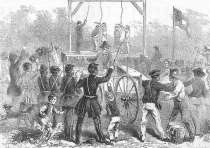
The bridge burning operation isolated Confederate command in Knoxville, but conspirators were captured and executed. Parson Brownlow witnessed two of the hangings while imprisoned in Knoxville.
A small community of potters, known as “Pottertown,” joined Unionists in a plan to sever Confederate communications and rail service in East Tennessee by burning nine bridges. President Abraham Lincoln planned to invade East Tennessee as the bridge burning operation was carried out and pledged compensation and protection for the bridge burners and their families. Potter Jacob Harmon Jr. rallied supporters at his farm on November 7, 1861. After swearing into Federal service on November 8, the men apprehended Confederate soldiers encamped in the area, destroyed Lick Creek bridge, and released the prisoners. Unfortunately for the potters, Lincoln’s commander of the Department of the Cumberland, Gen. William T. Sherman, did not allow his army to proceed with the invasion. Five of nine bridges were rendered inoperable, temporarily halting rail service on three railroad lines. The Unionists also damaged telegraph lines, severing Confederate communication and “isolating” command in Knoxville. Enraged, the Confederate command demanded swift and brutal justice. The bridge burners were to be caught, tried, “and if found guilty, executed on the spot by hanging… It would be well to leave their bodies hanging in the vicinity of the burned bridges.” Potters Jacob and Henry Harmon and Christopher A. Haun were convicted, sentenced to death, and hanged in Knoxville, Tennessee. Witnessing the final moments of Jacob and Henry Harmon (father and son) from a jail cell, the future Tennessee governor “Parson” Brownlow recorded the events: One day they came with two carts and took old [Jacob] Harmon—a Methodist class-leader—and his son [Henry]. Old Mr. Harmon was seated in one cart upon his coffin, and his son in the other, and each cart was surrounded by a strong guard of Rebel bayonets...The young man was hung first, and the father was compelled to look upon his death-struggles. Then he was told to mount the scaffold; but, being feeble and overpowered by his feelings, two of the ruffians took hold of him, one of them saying, “Get up there, you damned old traitor!” and the poor old man was launched into eternity after his son.
Tools
Key Facts
- A group of potters joined together to destroy 5 of 9 railroad bridges to interrupt Confederate rail & telegraph service in East Tennessee
- A planned simultaneous invasion did not occur
- Captured bridge burners were executed




